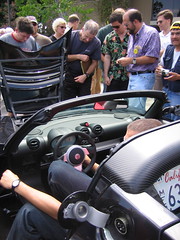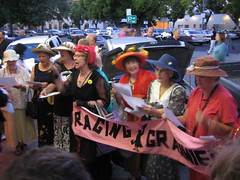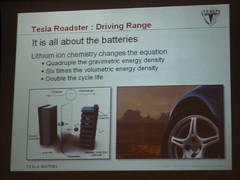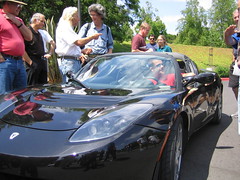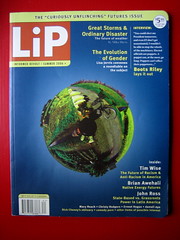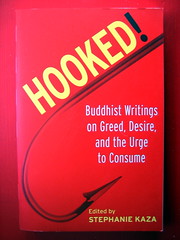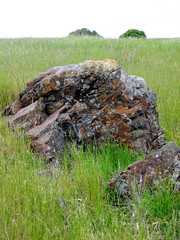Real Men Don't Go Vroom!
It is seldom that I find myself in the company of men, but looking at the roomful of 200 or so who had arrived at HP for this presentation, I was definitely one of only a handful of women. Nor did I feel out of place. This was the home of the Electric Auto Association and, as the owner of one of the more esoteric electric vehicles still on the road, my membership card was stamped and valid.
The EAA, now a national organization with numerous chapters all over the country, was founded by a group of owners in 1967 here in Silicon Valley. One of their members worked at Hewlett Packard, thus securing this beautiful presentation room for meetings. Seldom had I seen it filled to standing room only. It was as packed as a church on Christmas Eve. And in a sense this was Christmas for the EV world. We were here to see the Tesla, the stuff that EV dreams are made of.
The Tesla would show the world that electric cars were definitely not dead yet. In fact the Tesla might well be the death knell of the combustion engine itself, way ahead of the fuel cell car. And how would this come to pass? The key was in the lithium battery pack, which allowed the car a range of 250 miles. Range had long been the limiting factor of electric cars. Because standard cars can go 300 miles or so between fill ups, this had become the range to beat. Even though most Americans don't travel nearly that far in a day, the idea that they could has become part of our birthright. As a nation we had invested, not in high-speed trains or local municipal transit, but in an interstate highway. This was a land shaped by the automobile.
Nor could the automobile be a mere utilitarian object. Where once Henry Ford had decreed that buyers of his Model T could have any color they wanted as long as it was black, cars had to now represent what an owner believed in and aspired to, who his friends were, the power and status he had, his physical domination, even what political party he voted under. For at every stoplight the measure of the man would be up for review as his neighbor took in the car he drove.
Mid-life crisis? Get a sports car. Got a little dick, get a really big truck. Penis envy? Not me. I had a combustion engine between my legs. For the five years that I rode a motorcycle during my twenties, the roar and the vibrations against my thighs, the rush of speed and throbbing noise with every pull of the throttle was undeniably sexual (though low cost had been my aim). Add to that a full set of black leathers and I was strutting my stuff in the broadest representation of tough, kick ass, potency.
So it did not surprise me that the quiet of the electric car is considered effete or gay. Even mailmen objected when they were asked to drive electric mail vans, treating them badly and calling the vehicle a piece of junk. No, it takes a real man to drive an electric car. One that appreciates the beauty of its clean propulsion and the unobtrusive civilized quiet; one who is more than a little aware of the detrimental impact of the combustion engine on the planet.
EV owners I had met through the auto club were indeed sincerely nice, with a high level of concern for the planet. They were invested, not only in clean transportation, but often had solar power for their homes and were politically educated about policies that impacted energy use. They even packed their trash out of the movie theatre, when they came to see Who Killed The Electric Car, so reported my friend Tim who works at the Aquarius Theatre where the movie opened last month.
They were so nice, that when the Santana Row theatre asked them not to hand out fliers about the electric car, outside the theatre, when the the movie played at that venue, they packed up and left. It took the Raging Grannies to come back the following weekend with protest signs and songs to give the theatre and mall owners an earful about the right to free speech. I was triumphant when I saw they had made the 10 o'clock news for their ruckus. It was I who had told the Grannies the story of the theatre refusing to allow us to hand out fliers in a public venue.
Judging by the audience assembled at Hewlett Packard to hear about the Tesla Roadster, the electric car was also a geeks' car. I sat next to a man wearing a phone in his ear. Its periodic blinking made me turn to look at it. Our chapter president opened the meeting and quickly reviewed chapter business so we could welcome to the podium the young man who was Chief Technical Officer of Tesla. JB Straubel was articulate without the arrogance of a salesman, as he told the story of the Tesla with his PowerPoint presentation.
It had the body of the Lotus Elite, an English sports car, which though small, had enormous sex appeal. The car was built light, on an aluminum chassis with a full carbon body. The bodies are shipped from England to the Tesla company in San Carlos to be assembled (right in my own backyard; it did make me proud). The motor for the car was made in Taiwan and the battery pack assembled in Thailand. (So far the car had covered my country of birth, my current home and now Thailand - a factory in Chunburi, not far from my Bangkok home.)
The audience was enjoying the story, but it wasn't until the slide showing the battery technology came up that the excitement was palpable. People leaned forward, took pictures of the screen and were standing up in the back. Geeks know about batteries. It had been 15 years since a new battery technology had been put in a car, JB told us, far behind laptop and cell phone technology.
The batteries with the most energy density are lithium ion cells used in laptops, so why not string a bunch of them together to power a car? It meant hundreds of connections between battery cells had to be made, thus the cheap labor of the factory in Thailand. The resulting battery pack is water-cooled and is good for 500 charge and discharge cycles, which works out to 125,000 miles. And then it's recyclable.
The motor has a 2-speed gearbox with electronic shift. There is no revving up with an electric car. The full power of the high torque motor is available as soon as you step on the pedal. At 0 to 60 in 4 seconds, it is fast; shift into second and it's over 130 mph fast. The car has already beaten the Porsche and Ferrari in a face-to-face showdown at a track.
So far we have sex appeal, tremendous speed and comparable range. What more could we ask? Okay at $100,000 to own one, it is a tad expensive. A few audience members voiced this objection, but most understood that the high price would only make it more desirable to rich people. And when the rich must have something, then everyone else will lust after it until there are enough customers to bring the price down. As of this writing, the first one hundred of the signature model is already sold out with not a single car delivered.
Meanwhile Detroit and the Japanese are invested in the fuel cell car which has yet to pack enough hydrogen on board to go more than 100 miles and will set you back a million dollars. Not to mention that there are few hydrogen filling stations. The Tesla could plug in at home and be charged in 3 to 4 hours.
At the end of the presentation, the crowd hurried out to see the car. There it was sleek and black. We crowded around it, taking pictures. We were not being offered test drives, but we could touch it. In the hot sun we milled around and stuck our heads into the driver's side to see the view from behind the wheel.
Stepping back to watch the crowd go ape shit for this car, the man next to me mentioned the high price. "Well," I felt compelled to say, "A bicycle is still a very elegant and efficient way to get around." He surprised me by agreeing with me. Yes, there was something about the Tesla Roadster that was a little too rich for our blood. No longer was the electric car just about fuel conservation and ecological awareness, most popularly embodied by Prius owners. (Catherine has just joined the ranks, having scored a used silver Prius '05. The owner is returning to Manhattan where he won't need a car).
In appealing to the materialism of style and speed, the Tesla had thrown a curve ball into the eco crowd. So did that make being an eco-enlightened driver about speed? Wasn't that a little too much a desire to dominate the planet, not save it? The quiet whoosh with which the Tesla took off might well become the machismo of the future. Where would that lead us?
Would Tesla stoop to marketing the roadster with buxom babes draped all over the car? asked members on our yahoo group.
The Tesla Motors master plan is ultimately altruistic. For with the first 500 hundred sold, the money will be poured back into the company to make more cars and the next model will sell for 89K until the price comes down enough to make a family sedan model affordable. With a viable electric car on the road, the shift to a solar electric economy could then be ushered in. Tesla would even arrange for panels to be installed on your home. It was all we had hoped for. That our sensibilities were being challenged might just portend a new, totally stylin', eco-cool.
You, too, can see the Tesla at the upcoming EV Rally which will be at Palo Alto High School on September 30th from 10 a.m. to 4 p.m. We'll all be there and the Raging Grannies, too.
Published concurrently at energy bulletin
